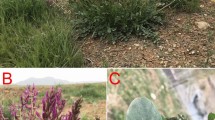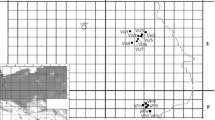Abstract
Alhagi Gagnebin (Fabaceae: Hedysareae) is a small genus of shrubs or subshrubs distributed in temperate and tropical regions of Asia, Europe, and Africa. The exact number of Alhagi species in Iran has been disputable. Studies showed that morphology, seed protein, and chromosome characters could not clearly delimitate the species boundaries of the genus. In order to determine species boundaries and the population structure of Alhagi species in Iran, eight labeled inter simple sequence repeat (ISSR) primers were used to screen 22 populations including 110 individuals. STRUCTURE, PCoA and clustering analyses of ISSR data were able to clearly split all populations of Alhagi in Iran into two distinct groups. As the populations A. pseudalhagi and A. maurorum jointly formed a group (A. maurorum complex) segregated from those of Alhagi graecorum. Further analyses of A. maurorum complex showed a significant molecular difference among the studied populations (PhiPT value = 0.213, P = 0.001) as well as a high amount of variability within populations (79%) indicating frequent genetic exchanges. Structure analysis of complex populations (K = 2) showed no distinct genetic pattern related to their geographical distribution. In this study, Alhagi has retrieved the only two species of Alhagi in Iran; A. graecorum and A. maurorum.





Similar content being viewed by others
References
Legume Phylogeny Working Group (2013) Legume phylogeny and classification in the 21st century: progress, prospects and lessons for other species-rich clades. Taxon 62(2):217–248. https://doi.org/10.12705/622.8
Stevens PF (2017) Angiosperm Phylogeny Website, version 14. Available at http://www.mobot.org/MOBOT/research/APweb. Accessed 20 Aug 2020
Awmack C, Lock J (2002) The genus Alhagi (Leguminosae: Papilionoideae) in the Middle East. Kew Bull 57(2):435–443. https://doi.org/10.2307/4111121
Xu L, Larsen K (2010) Alhagi Gagnebin. In: Wu Z, Raven P, Hong D (eds) Flora of China, vol. 10 (Fabaceae). Missouri Botanical Garden Press, Beijing, St. Louis, pp 526–527
Meikle RD (1977) Flora of Cyprus, vol. 1. Royal Botanic Gardens, Kew, London.
Zahran M, Willis A (1992) The vegetation of Egypt. Springer, Netherlands
Sheidai M, Yazdanbakhsh Z, Assadi M, Moussavi M (2001) Cytology and morphometry study of Alhagi (Leguminosae) species in Iran. Nord J Bot 21(1):83–91. https://doi.org/10.1111/j.1756-1051.2001.tb01341.x
Ahangarian S, Kazem POS, Maassoumi AA (2007) Molecular phylogeny of the tribe Hedysareae with special reference to Onobrychis (Fabaceae) as inferred from nrDNA ITS sequences. Iran J Bot 13(2):64–74
Amirahmadi A, Kazempour-Osaloo S, Moein F, Kaveh A, Maassoumi AA (2014) Molecular systematics of the tribe Hedysareae (Fabaceae) based on nrDNA ITS and plastid trnL-F and matK sequences. Plant Syst Evol 300(4):729–747. https://doi.org/10.1007/s00606-013-0916-5
Duan L, Wen J, Yang X, Liu PL, Arslan E, Ertuğrul K, Chang ZY (2015) Phylogeny of Hedysarum and tribe Hedysareae (Leguminosae: Papilionoideae) inferred from sequence data of ITS, matK, trnL-F and psbA-trnH. Taxon 64(1):49–64. https://doi.org/10.12705/641.26
Liu P-L, Wen J, Duan L, Arslan E, Ertuğrul K, Chang Z-Y (2017) Hedysarum L. (Fabaceae: Hedysareae) is not monophyletic-evidence from phylogenetic analyses based on five nuclear and five plastid sequences. PLoS ONE 12(1):e0170596. https://doi.org/10.1371/journal.pone.0170596
Chamberlain DF (1970) Alhagi Gagnebin. In: Davis PH (ed) Flora of Turkey and the East Aegean Islands, vol 3. Edinburgh University Press, Edinburgh, pp 596–597
Ali SI (1977) Alhagi Gagnebin. In: Nasir E, Ali SI (eds) Flora of West Pakistan, no. 100: Papilionaceae. University of Karachi, Karachi, pp 319–320
Rechinger KH (1984) Alhagi. In: Rechinger KH (ed) Flora Iranica, no. 157: Papilionaceae. Akademische Druck-und Verlagsanstalt, Graz, pp 470–475
Wu Z, Raven P, Hong D (2010) Flora of China, vol. 10: Fabaceae. Beijing and Missouri Botanical Garden Press, St. Louis
Sheidai M, Yazdanbakhsh Z, Bernard F (2002) Seed protein analysis of Alhagi (Leguminosae) species and populations. Iran J Bot 9(2):141–149
Mabberly DJ (2017) Mabberly’s plant-book: a portable dictionary of plants, their classification and uses, 4th edn. Cambridge University Press, Cambridge
Amirkhosravi A, Asri Y, Assadi M, Mehregan I (2020) Systematics of Alhagi: molecular phylogeny and morphology revisited. Rostaniha 21(2):174–184. https://doi.org/10.22092/botany.2020.343028.1200
Freeland JR (2005) Molecular ecology. Wiley, West Sussex
Godwin ID, Aitken EAB, Smith LW (1997) Application of inter-simple sequence repeat (ISSR) markers to plant genetics. Electrophoresis 18(9):1524–1528. https://doi.org/10.1002/elps.1150180906
Wolfe AD, Liston A (1998) Contributions of PCR-based methods to plant systematics and evolutionary biology. In: Soltis DE, Soltis PS, Doyle JJ (eds) Molecular systematics of plants II. Springer, Boston, pp 43–86. https://doi.org/10.1007/978-1-4615-5419-6_2
Pradeep-Reddy M, Sarla N, Siddiq E (2002) Inter simple sequence repeat (ISSR) polymorphism and its application in plant breeding. Euphytica 128(1):9–17. https://doi.org/10.1023/A:1020691618797
Ng W, Tan S (2015) Inter-simple sequence repeat (ISSR) markers: are we doing it right. ASM Sci J 9(1):30–39
Abate T (2017) Inter simple sequence repeat (ISSR) markers for genetic diversity studies in Trifolium Species. Adv Life Sci Technol 55:33–37
Doyle JJ, Doyle JL (1987) A rapid DNA isolation procedure for small quantities of fresh leaf tissue. Phytochem Bull 19(1):11–15
Doyle J (1991) DNA protocols for plants. In: Hewitt GM, Johnston AWB, Young JPW (eds) Molecular techniques in taxonomy. NATO ASI series (series H: cell biology), vol 57. Springer. Berlin, Heidelberg, pp 283–293
El-Hady E, Haiba AA, El-Hamid NRA, Al-Ansary A, Mohamed AY (2010) Assessment of genetic variations in some Vigna species by RAPD and ISSR analysis. N Y Sci J 3(11):120–128
Agarwal T, Gupta AK, Patel AK, Shekhawat N (2015) Micropropagation and validation of genetic homogeneity of Alhagi maurorum using SCoT, ISSR and RAPD markers. Plant Cell Tissue Org Cult 120:313–323. https://doi.org/10.1007/s11240-014-0608-z
Hammer Ø (2012) PAST: paleontological statistics version 2.17, reference manual. Natural History Museum, University of Oslo, Oslo
Peakall R, Smouse PE (2006) GENALEX 6: genetic analysis in Excel. Population genetic software for teaching and research. Mol Ecol Notes 6(1):288–295. https://doi.org/10.1111/j.1471-8286.2005.01155.x
Nei M (1972) Genetic distance between populations. Am Nat 106(9):283–292. https://doi.org/10.1086/282771
Nei M (1973) Analysis of gene diversity in subdivided populations. Proc Natl Acad Sci USA 70(12 Pt 1–2):3321–3323. https://doi.org/10.1073/pnas.70.12.3321
Yeh FC, Yang RC, Boyle T (1999) POPGENE version 1.31. Microsoft window-based freeware for population genetic analysis. University of Alberta, Edmonton
Pritchard JK, Stephens M, Donnelly P (2000) Inference of population structure using multilocus genotype data. Genetics 155(2):945–959
Evanno G, Regnaut S, Goudet J (2005) Detecting the number of clusters of individuals using the software structure: a simulation study. Mol Ecol 14(8):2611–2620. https://doi.org/10.1111/j.1365-294X.2005.02553.x
Yakovelov GP (1979) Notes on the taxonomy of the genus Alhagi Gagneb (Fabaceae). Bot Zhurnal 64(1):1794–1799
Lock JM, Simpson K (1991) Legume of the West Asia: a check-list. Royal Botanical Gardens, Kew, London
Matin-Fard MM, Bazubandi M, Karimi-Shahri MR (2010) Investigation of genetic diversity in Alhaji Pseudoalhaji using RAPD-PCR molecular markers. Proceeding of the 3rd Iranian Weed Science Congress, vol. 2, pp 630–634. February 2010, Babolsar. Available at https://www.cabdirect.org/cabdirect/abstract/20103165335. Accessed 17–18 Feb 2010
Abd El-Hak GhM, Ibrahim Sh, Halem A, Hassan ZH, Rayan WA (2019) Assessment of genetic diversity in different geographically isolated Alhagi graecorum Boiss. populations using SCoT marker. Taeckholmia 39(1):44–66. https://doi.org/10.21608/taec.2019.19481.1008
Boissier E (1872) Flora Orientalis: sive, Enumeratio plantarum in Oriente a Graecia et Aegypto ad Indiae fines hucusque observatarum 2. Genevae, Basileae & Lugduni: H. Georg
Acknowledgements
The authors would like to thank the staff at IAUH and TARI herbaria for their help.
Funding
This work was supported by the Islamic Azad University, Science and Research Branch, Tehran, Iran.
Author information
Authors and Affiliations
Corresponding author
Ethics declarations
Conflict of interest
The authors declare that they have no conflict of interest.
Additional information
Publisher's Note
Springer Nature remains neutral with regard to jurisdictional claims in published maps and institutional affiliations.
Rights and permissions
About this article
Cite this article
Amirkhosravi, A., Asri, Y., Assadi, M. et al. Genetic structure of Alhagi (Hedysareae, Fabaceae) populations using ISSR data in Iran. Mol Biol Rep 48, 5143–5150 (2021). https://doi.org/10.1007/s11033-021-06511-w
Received:
Accepted:
Published:
Issue Date:
DOI: https://doi.org/10.1007/s11033-021-06511-w




